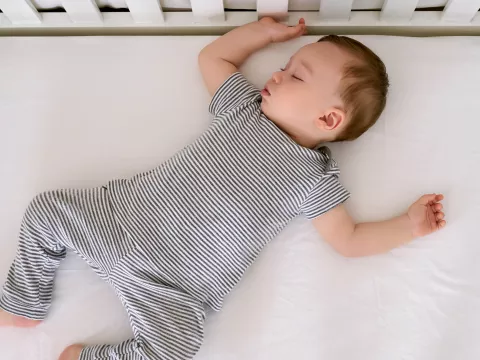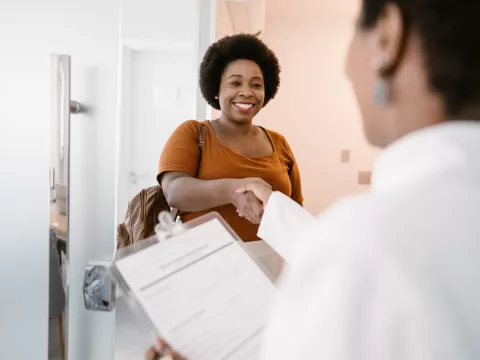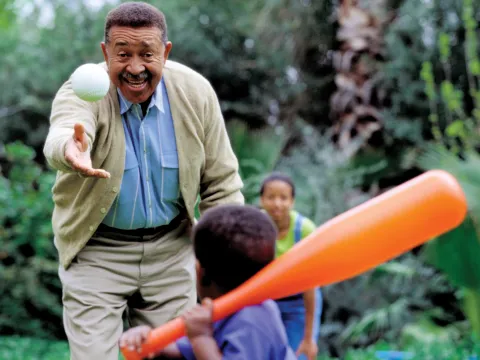- AdventHealth

Choose the health content that’s right for you, and get it delivered right in your inbox.
Whether you’re an expecting parent, a brand-new parent, a grandparent or a caregiver, knowing your sleep safety ABCs by heart for your newest family member is an important foundation for your little one’s well-being.
Sleep can be a challenge for the whole family as you adjust to a new routine when you bring your baby home. With so much to remember when it comes to taking care of your little one, we’re here to break down the ABCs of infant sleep safety for you. Parents and caregivers can rest a little easier knowing that their newborns are safe and sound as they sleep.
What Are the ABCs of Sleep Safety for Babies?
The ABCs of infant sleep safety are:
A: Alone
B: Back
C: Crib
Let’s look at each one in more detail.
A is for Alone
Babies should sleep alone, in their own sleep space with no other people. Room-sharing is recommended, but bed-sharing is not. Keep pillows, blankets, toys, stuffed animals, hats, hair bows and all other soft items out of their sleep space. This is for their safety so they are not accidentally smothered by a stray item or another person while they sleep.
Room-sharing without bed-sharing reduces the risk of SIDS (Sudden Infant Death Syndrome) by as much as 50%. You’ll still be close to your baby without the risk of accidental smothering.
B is for Back
“Back is best.” Your baby should be positioned for sleep flat on their back, never on the tummy or side. This is the most important and effective strategy for preventing SIDS.
Around three months of age, your baby may begin to learn how to roll from back to tummy and tummy to back. When your little one can roll over both ways independently, it’s OK to leave your child on their tummy if they roll over while sleeping, but always place them on their back initially. When your baby can roll, you should no longer swaddle them so they can maneuver safely.
C is for Crib
Use a crib, bassinet or portable play yard with a flat, firm mattress and a fitted sheet. The crib shouldn’t have any bumpers, and nothing should be attached to it that can fall in with your baby (like mobiles and monitors). Babies can sleep in a swaddle (wrapped no higher than their shoulders) until they can roll over. They can use a sleep sack with their arms out after that.
Avoid letting your baby sleep on a couch or armchair, or in another device like a swing or bouncer. Falling asleep in a car seat is OK, but only while riding in the car. Gently remove your baby from the car seat and place them safely in their crib once you arrive home.
How to Make a Safe Sleep Environment and Reduce SIDS Risk
Here are some tips on how to create a safe sleep environment and reduce the risk of SIDS for your little one:
- Always place babies on their backs to sleep at naptime and bedtime, not on their stomach or side
- Breastfeed, if possible, for at least six months; it can decrease the risk of SIDS
- Don’t let your baby overheat during sleep
- Don’t use bouncy seats, swings, infant carriers or strollers for routine sleep
- Don’t use home cardiorespiratory monitors as a substitute for safe sleep practice
- Don’t smoke or let anyone smoke around your baby
- Dress your baby in comfortable sleep clothing, such as a one-piece or wearable blanket
- Hold your baby when bottle feeding; propping bottles can lead to choking
- Keep your baby’s sleep area in the same room where you sleep; room-sharing is recommended
- Make sure nothing covers your baby’s head or face while they sleep
- Pacifiers should not be attached to a string for naps and nighttime sleep
- Place your baby in a safety-approved crib, bassinet or portable crib for sleep
- Provide tummy time only when your baby is awake and being closely watched
- Remove all soft bedding from your baby’s sleep area
- There should be no pillows, loose blankets, furlike materials, soft or weighted objects, crib bumpers or toys in your baby’s sleep area — these increase the risk of suffocation, entrapment and strangulation
- Use a firm and flat sleep surface covered by a fitted sheet; a soft surface can block a baby’s airway
- Vaccinate your baby and get regular health checkups according to your pediatrician’s recommendations
- Your baby should sleep alone in their own bed
- Your baby should not sleep in an adult bed, on a couch or on a chair alone, with you or with anyone else
Building Blocks for Safe Sleep
Now that you know the ABCs for your baby to sleep safely, make sure that anyone who may care for your baby knows and practices these rules as well. They are important building blocks to a happy, healthy and safe start for your little one. To discuss any specific sleep questions, consult your pediatrician.
For more educational resources on safe sleep, visit CribsforKids.org.




